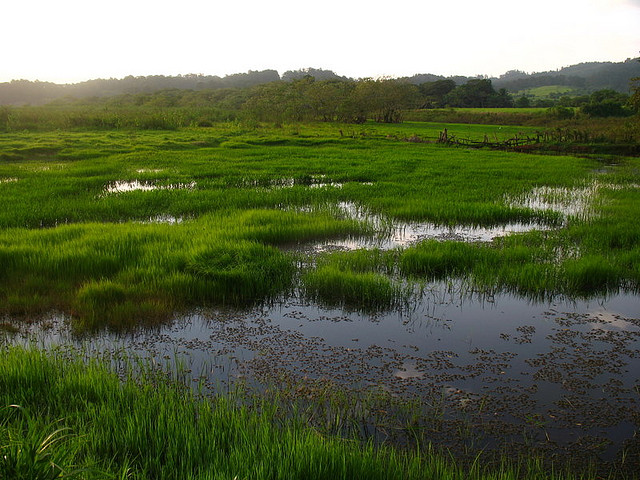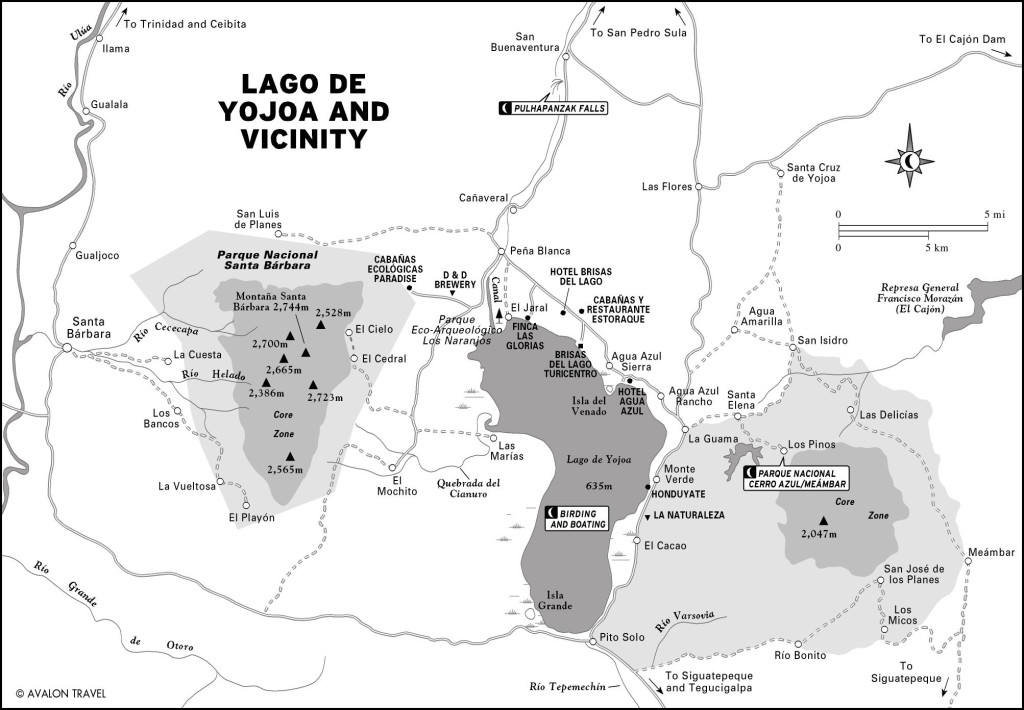
Lago de Yojoa. Photo © Martijn Munneke, licensed Creative Commons Attribution.
Honduras’s largest natural lake, Lago de Yojoa, is roughly 16 kilometers long by 8 kilometers wide, at an altitude of 635 meters, right along the San Pedro Sula–Tegucigalpa highway. Lake depth varies between about 18 and 25 meters, depending on season. The setting, backed by the majestic cloud-forested mountains of Santa Bárbara and Cerro Azul/Meámbar (both protected as national parks), is spectacular. Formerly overlooked by many Central America travelers, Lago de Yojoa is growing in popularity as a spot well worth visiting for a few days of hiking, ruins exploration, bird-watching, or just soaking up the glorious scenery. The shores of the lake are dotted with innumerable ruins, mostly believed to be of Lenca origin, including Los Naranjos.The shores of the lake are dotted with innumerable ruins, mostly believed to be of Lenca origin, including Los Naranjos. Along with the Valle de Sula, Lago de Yojoa is thought to have been one of the most heavily populated areas in Honduras in pre-Columbian times, used as a home by the Lenca, Maya, and perhaps other groups.The lake is drained naturally on the south side by Río Tepemechín, which leads eventually into the Río Ulúa, and on the north by the Río Blanco, which has been partly channeled to power a hydroelectric plant at Cañaveral. Along the Río Lindo, a tributary to the Río Blanco, is Pulhapanzak Falls, an easily visited and very beautiful 43-meter waterfall.
Regular buses ply the roads around the lake, between Peña Blanca and El Mochito, La Guama, and Pulhapanzak Falls. If no buses are immediately apparent, just stick out your thumb—hitchhiking is fairly reliable.

Lago de Yojoa and Vicinity
Largemouth bass fishing in the lake was once legendary on Lago de Yojoa, attracting anglers from across the globe, but the bass population has declined due to overfishing. Much more common nowadays is tilapia, a nonnative species. Large fish farms on the lake produce as many as 20 tons of harvested fish per day. Fishing on the lake is certainly possible, but the lake itself isn’t the cleanest, and it’s better to get your tilapia from one of the fish farms that has some controls.
A ride on a motorboat or sailboat can be arranged on the lake by contacting Honduyate. A few locals stationed along the canal between Peña Blanca and the lake also rent rowboats for a nominal fee (usually around US$2) for tourists to paddle out onto the lake. One spot to look for them is about two kilometers from Peña Blanca on the El Mochito road, where the road takes a sharp turn. Here a path leads down to the canal’s edge. There is also a sign advertising boats for rent (se aquila lanchas) just before the D&D Brewery, and the turicentro run by the Brisas del Lago hotel is open to nonguests as well. Boats are also available at the lakeside hotels Agua Azul and Finca Las Glorias, the latter being a lovely setting for lunch. This is a good way for bird-watchers to patrol some of the wetlands around the edge of the lake.
The extensive marshes and forests around Lago de Yojoa, located in the transition zone between the Valle de Sula and the central highlands, boast the country’s largest variety of bird species. One count put the number of species at 407. Whatever the exact number, the lake and surrounding forests are a birder’s paradise. One particularly good spot is at Hotel Agua Azul or the nearby Isla del Venado; another is the foothills of Santa Bárbara near San Luis de Planes.
There’s plenty of good birding at Lago de Yojoa for non-experts, with easily spotted hawks and herons on the lake, and a good chance of seeing a toucan. Do-it-yourselfers can rent boats at many of the hotels around the lake, or take a walk through the property at Centro Turístico Paradise (they have a small set of trails) near Peña Blanca.
But if you’d like a pair of expert eyes to help do the spotting, you may want to arrange for a guided bird tour. Local ornithologist Malcolm Glasgow stops by the D&D Brewery at dinnertime to pitch guests his tours: US$13 per person for a tour by rowboat on the lake, or US$79 per person for an overnight hike in the cloud forest of the Santa Bárbara National Park, including transportation, food, and accommodations. (It’s not necessary to be staying at the brewery to book a tour; call them if you’re not able to stop by at dinnertime.) Malcolm can also help you find specific birds if you’ve got a “checklist” and are looking for one or two in particular.
More serious birders may want to contact Daniel Germer, head of Honduras’s Ornithological Society, who also works as a private guide.
Excerpted from the Sixth Edition of Moon Honduras.